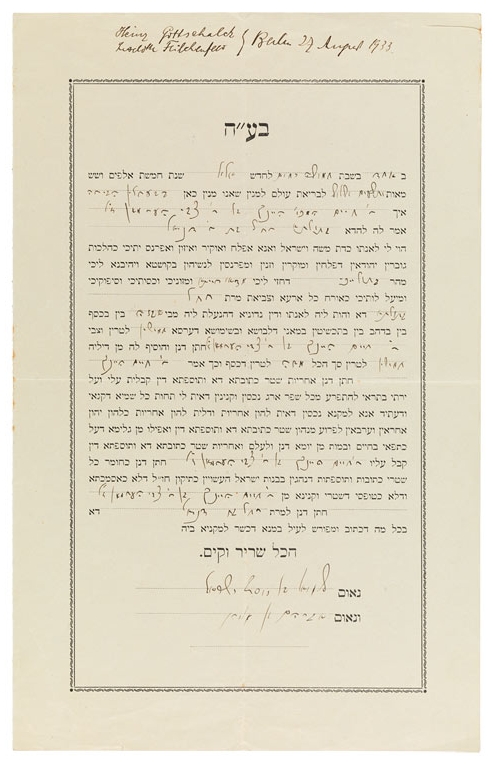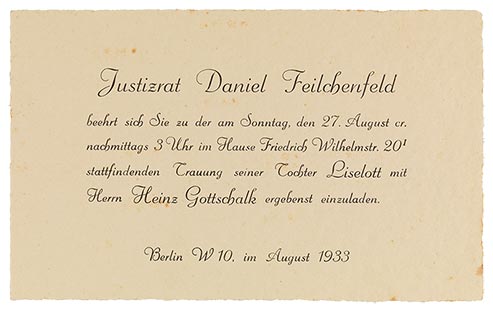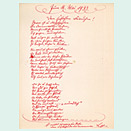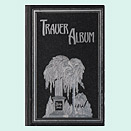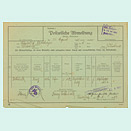On the afternoon of 27 August 1933 a large group of friends and relatives gathered in Daniel Feilchenfeld‘s apartment in the Tiergarten district of Berlin. Ten days earlier Daniel‘s daughter Liselott (1909–2006) had married her fiancé Heinz Gottschalk (1902–1987) at the registry office and the couple was now having their religious wedding ceremony. The marriage became legally binding once they signed the Jewish marriage contract shown here, known as a ketubah.
A quick glance reveals that the document was a preprinted form with various handwritten entries, including the date of the wedding, names of the bride and groom, the amount of money they were both bringing to the marriage, and signatures of the two witnesses making the contract valid. The text is in Aramaic and its phrasing has not changed for centuries. It establishes the groom‘s duties and responsibilities to his bride during the marriage and in the event of his death.
The day after the ceremony, on 28 August, a small wedding announcement was published in the Jüdische Rundschau, the official organ of the Zionist Association of Germany. The newlyweds may have read it themselves on the train to Italy—as they made their way to Palestine.
Ulrike Neuwirth and Aubrey Pomerance
In the marriage contract, the two spouses are referred to by their Hebrew names Chaim (Heinz Gottschalk) and Rachel (Liselott Feilchenfeld).
Heinz Gottschalk
Liselotte Feilchenfeld Berlin 27 August 1933
With the help of God
On the first day of the week, the fifth day of the month of Elul, the year 5693 after the creation of the world, according to the manner in which we count dates here in Berlin, the bridegroom Herr Chaim, called Heinz, son of Herr Zwi Hermann, may his memory be blessed, said to the virgin Rachel, daughter of Herr Daniel:
"Be my wife according to the practice of Moses and Israel, and I will cherish, honor, support and maintain you in accordance with the custom of Jewish husbands who cherish, honor, support and maintain their wives faithfully. And I hereby present you with the marriage gift of virgins, which belongs to you according the law of Moses and Israel; and I will also give you your food, clothing and necessities, and live with you as husband and wife according to universal custom." And the virgin Rachel consented and became his wife.
The dowry that she brought to him from her father‘s house in silver, gold, valuables, clothing, furniture and bedclothes, all this the said bridegroom, Herr Chaim Heinz, son of Herr Zwi Hermann, may his memory be blessed, accepted in the sum of fifty silver pieces. And the bridegroom consented to increase this amount from his own property with the sum of fifty silver pieces, making in all one hundred silver pieces.
And thus said Herr Chaim Heinz, the bridegroom: "The responsibility of this marriage contract, of this dowry, and of this additional sum, I take upon myself and my heirs after me, so that they shall be paid from the best part of my property and possessions that I have beneath the whole heaven, that which I now possess or may hereafter acquire. All my property, real and personal, even the shirt from my back, shall be mortgaged to secure the payment of this marriage contract, of the dowry, and of the addition made to it, during my lifetime and after my death, from the present day and forever."
The bridegroom, Herr Chaim Heinz, son of Herr Zwi Hermann, may his memory be blessed, has taken upon himself the responsibility of this marriage contract, of the dowry and the addition made to it, according to the restrictive usage of all marriage contracts and the adjoins to them made for the daughters of Israel, according to the institution of our sages of blessed memory. It is not to be regarded as a mere forfeiture without consideration or as a mere formula of a document.
We have followed the legal formality of symbolic delivery between the bridegroom, Herr Chaim Heinz, son of Herr Zwi Hermann, may his memory be blessed, and the bride, Rachel, daughter of Daniel, and we have used a garment legally fit for the purpose, to strengthen all that is stated above, and everything is valid and confirmed.
Attested to by Schmuel, son of Josef Israel, witness
Attested to by Awraham, son of Elijahu, witness
